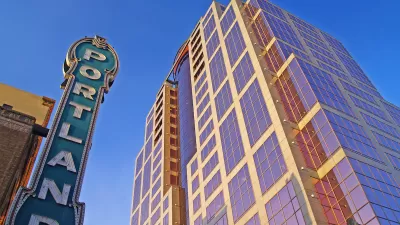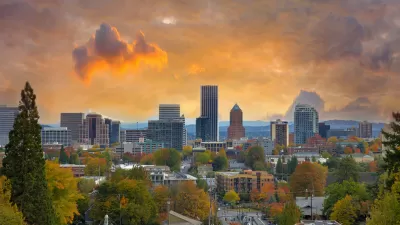As St. Louis and Portland speed along with new streetcar developments, Yonah Freemark considers how zoning may determine the success of one, and the failure of another.
Cities across the United States are looking to streetcars as development tools first, and transportation systems second. But, as The Transport Politic's Yonah Freemark reports, some cities are overlooking the need to modify zoning for parcels adjacent to streetcar stations to allow and incentivize the development they're hoping for.
Comparing new streetcar lines in Portland and St. Louis, some surprising differences emerge. On some of St. Louis' most transit-accessible lots, for example, "...buildings cannot exceed three stories or 45 to 50 feet," reports Freemark. "Meanwhile, non-pedestrian-oriented uses, such as drive-through restaurants, are allowed to be constructed. For residential buildings, developers are required to provide parking for one car per unit, and commercial structures over a size limit must provide parking as well."
For comparison, "[w]ith the densities allowed in Portland, significant new construction in the Eastside areas will be possible," says Freemark. Portland can also expect to see an increased downtown population and lower automobile usage, a result of the streetcar and relaxed zoning standards.
FULL STORY: Don’t Forget the Zoning

Study: Maui’s Plan to Convert Vacation Rentals to Long-Term Housing Could Cause Nearly $1 Billion Economic Loss
The plan would reduce visitor accommodation by 25,% resulting in 1,900 jobs lost.

North Texas Transit Leaders Tout Benefits of TOD for Growing Region
At a summit focused on transit-oriented development, policymakers discussed how North Texas’ expanded light rail system can serve as a tool for economic growth.

Why Should We Subsidize Public Transportation?
Many public transit agencies face financial stress due to rising costs, declining fare revenue, and declining subsidies. Transit advocates must provide a strong business case for increasing public transit funding.

How to Make US Trains Faster
Changes to boarding platforms and a switch to electric trains could improve U.S. passenger rail service without the added cost of high-speed rail.

Columbia’s Revitalized ‘Loop’ Is a Hub for Local Entrepreneurs
A focus on small businesses is helping a commercial corridor in Columbia, Missouri thrive.

Invasive Insect Threatens Minnesota’s Ash Forests
The Emerald Ash Borer is a rapidly spreading invasive pest threatening Minnesota’s ash trees, and homeowners are encouraged to plant diverse replacement species, avoid moving ash firewood, and monitor for signs of infestation.
Urban Design for Planners 1: Software Tools
This six-course series explores essential urban design concepts using open source software and equips planners with the tools they need to participate fully in the urban design process.
Planning for Universal Design
Learn the tools for implementing Universal Design in planning regulations.
City of Santa Clarita
Ascent Environmental
Institute for Housing and Urban Development Studies (IHS)
City of Grandview
Harvard GSD Executive Education
Toledo-Lucas County Plan Commissions
Salt Lake City
NYU Wagner Graduate School of Public Service





























